CHAPTER 1 Introduction
The Standard for Portfolio Management – Second Edition, has been significantly expanded from the original
version. Starting with the basic original materials, two knowledge areas specific to managing portfolios have been
added.
Design of the Document
The Standard for Portfolio Management is organized into two sections:
• Section 1: Portfolio Management Overview, Framework, and Processes. This section provides a
basis for understanding Portfolio Management. There are three chapters in this section.
o Chapter 1: The introduction presents a basis for the standard. It defines what a portfolio is and
discusses portfolio management, the interaction among project, program, and portfolio
management, and presents an outline of the remaining document.
o Chapter 2: Portfolio Management Overview and Organization provides an overview of the
process, describes stakeholder roles, and organization influences.
o Chapter 3: Portfolio Management Processes defines the two process groups: Aligning and
Monitoring and Controlling and maps the portfolio knowledge areas to those.
• Section 2: Portfolio Management Knowledge Areas. This section lists the portfolio management
processes and enumerates the inputs, tools and techniques, and outputs for each area. Each chapter
focuses on a portfolio specific knowledge area.
o Chapter 4, Portfolio Governance, describes the processes involved in developing a structure for
ensuring quality and oversight to the portfolio. The chapter consists of the following processes:
a.
b.
c.
d.
e.
f.
g.
h.
i.
j.
Identify Components,
Categorize Components,
Evaluate Components,
Select Components,
Prioritize Components,
Balance Portfolio,
Communicate Portfolio Adjustment,
Authorize Components,
Review and Report Portfolio Performance, and
Monitor Business Strategy Changes.
o Chapter 5, Portfolio Risk Management, describes the processes concerned with conducting risk
management for portfolios. The chapter consists of the following processes:
a.
b.
c.
d.
Identify Portfolio Risks,
Analyze Portfolio Risks,
Develop Portfolio Risk Responses, and
Monitor and Control Portfolio Risks.
�
1.1 Purpose of The Standard for Portfolio Management
The primary purpose of The Standard for Portfolio Management is to describe generally recognized good
practices associated with portfolio management. “Generally recognized” means that the knowledge and
practices described are applicable to most portfolios most of the time, and that there is widespread consensus
about their value and usefulness. This standard is an expansion of and companion to information already
provided in A Guide to the Project Management Body of Knowledge (PMBOK® Guide) – Fourth Edition, The
Standard for Program Management – Second Edition, and the Organizational Project Management Maturity
Model (OPM3®) – Second Edition. As a foundational reference, this standard is neither intended to be
comprehensive nor all-inclusive.
This standard focuses on portfolio management as it relates to the disciplines of project and program
management. Its application is intended for all types of enterprises (i.e., profit, nonprofit, and government).
When the term “enterprise” is used here, it applies generally to these three types of enterprises. If any portion of
this standard typically is applicable to only to a subset of these, the subset is identified.
1.1.1 Audience for The Standard for Portfolio Management
This standard provides a foundational reference for anyone interested in managing a portfolio of projects and
programs. This includes, but is not limited to:
• Senior executives making decisions about enterprise strategy,
• Management staff responsible for developing enterprise strategy or those making recommendations to
senior executives,
• Portfolio managers,
• Researchers analyzing portfolio management,
• Members of a portfolio or program management office,
• Managers of project and program managers,
• Program managers,
• Project managers and other project team members,
• Consultants and other specialists in project, program, and portfolio management and related fields,
• Functional managers and process owners with resources in a portfolio,
• Customers and other stakeholders, and
• Educators teaching the management of portfolios and related subjects.
1.2 What is a Portfolio?
A portfolio is a collection of projects (temporary endeavors undertaken to create a unique product, service, or
result) and/or programs (a group of related projects managed in a coordinated way to obtain benefits and control
not available from managing them individually) and other work (such as maintenance on an initiative already
complete) that are grouped together to facilitate the effective management of that work to meet strategic business
objectives. These components of a portfolio are quantifiable; that is, they can be measured, ranked, and prioritized.
A portfolio always exists within an organization and it consists of a set of current components and planned
or future initiatives. Therefore, portfolios are not temporary like projects or programs. Proposed initiatives
become part of the portfolio when they are selected and approved.
�
At any given moment, the portfolio represents a view of its selected components and reflects the strategic
goals of the organization; however, specific projects or programs within the portfolio are not necessarily
interdependent or directly related. By reflecting investments made or planned by an organization, the portfolio
is where priorities are identified, investment decisions made, and resources allocated. Therefore, the portfolio
represents the work selected to be done, but not necessarily the work that should be done. If a portfolio’s
components are not aligned to its organizational strategy, the organization can reasonably question why the
work is being undertaken. Therefore, a portfolio is a true measure of an organization’s intent, direction, and
progress.
1.2.1 Portfolios vs. Programs vs. Projects
All components of a portfolio exhibit certain common features:
• They represent investments made or planned by the organization.
• They are aligned with the organization’s strategic goals and objectives.
• They typically have some distinguishing features that permit the organization to group them for more
effective management.
• The components of a portfolio are quantifiable; they can be measured, ranked, and prioritized.
Figure 1-1 illustrates the relationship of a portfolio and its components.
Figure 1-1. Portfolio Relationships—Example
A portfolio focuses on ensuring programs and projects are considered in relation to one another so resources
(e.g., people, funding) can be allocated in alignment to and consistent with organizational priorities. Programs
focus on achieving the benefits expected from the portfolio as determined by strategic organizational objectives.
Projects are largely concerned with achieving specific deliverables that support narrowly defined objectives.
The components of a portfolio can be further differentiated as shown in Table 1-1.
Table 1-1. Comparison of Project, Program, and Portfolio Attributes
�
1.3 What Is Portfolio Management?
Portfolio management is the centralized management of portfolio components to achieve specific business
objectives. While this standard focuses on “project portfolio management,” it is referred to throughout as simply
“portfolio management.”
Portfolio management is also an opportunity for a governing body to make decisions that control or
influence the direction of a group of components (a sub-portfolio, program, projects, or other work) as they
work to achieve specific outcomes. It uses the tools and techniques described in this standard to identify, select,
prioritize, govern, measure, and report the contributions of the components to, and their relative alignment with,
organizational objectives. It is not concerned with managing the components. The goal of portfolio management
is to ensure that the organization is “doing the right work,” rather than “doing work right.”
1.4 The Link between Portfolio Management and Organizational Governance
Organizations have governance frameworks in place to guide the execution of organizational activities.
Organizational governance establishes the limits of power, rules of conduct, and protocols that organizations use
to manage progress towards the achievement of their strategic goals. This is accomplished through controls
intended to maximize the delivery of value while minimizing risk. For the purposes of this standard,
organizational governance is the process by which an organization directs and controls its operations and strategic
activities, and by which the organization responds to the legitimate rights, expectations, and desires of its
stakeholders. Project portfolio governance is the process by which an organization prioritizes, selects, and
allocates limited internal resources to best accomplish organizational objectives.
Portfolio management is one discipline within organizational governance. Organizations that do not link
portfolio management to governance risk misaligned or low priority initiatives which will consume critical
resources. Therefore, applying the techniques of portfolio management within the context of organizational
governance provides reasonable assurance that the organizational strategy can be achieved.
Portfolio management is both a framework and a management activity. The framework directs the activity
of translating the organizational strategy into a portfolio of strategic and operational initiatives. The
management activity ensures actualization of those initiatives through the use of organizational resources.
�
Figure 1-2 illustrates the relationships between organizational governance, operational management, and
management of initiatives that comprise the portfolio. Governance principles ensure alignment between the
resulting activities and the organizational strategy.
In this figure, the controls that comprise organizational governance cascade to the domains of portfolio,
program, and project management. As the portfolio is executed, these controls are applied to maximize the
likelihood of the organization’s strategy. Managing these controls against the portfolio is the responsibility of
the portfolio manager, whose role is detailed in Chapter 1, Section 8. The processes that guide execution of
portfolio governance are discussed in Chapter 4.
Figure 1-2. Relationships among Organizational Governance, Operations, and Portfolio Management
1.5 The Relationship between Portfolio Management and Organizational Strategy
Organizations build strategy to define how their vision will be achieved. The vision is enabled by the mission,
which directs the execution of the strategy. For the purposes of this standard, organizational strategy is a plan that
describes how the company’s strengths and core competencies will be used to:
• Capitalize on opportunities,
• Minimize the impact of threats,
• Respond to changes in the market, and
�
• Reinforce focus on critical operational activities.
The goal of linking portfolio management to the strategy is to balance the use of resources to maximize
value in executing strategic and operational activities.
The organizational strategy is a result of the strategic planning cycle, where the vision and mission are
translated into a strategic plan. The strategic plan is subdivided into a set of initiatives that are influenced by
market dynamics, customer and partner requests, shareholders, government regulations, and competitor plans
and actions. These initiatives establish strategic and operational portfolios to be executed in the planned period.
Figure 1.3 depicts a general relationship between the strategic and operational processes in an organization.
Figure 1-3. The Organizational Context of Portfolio Management
“Vision,” “Mission,” and “Organizational Strategy and Objectives” illustrate the components used to set the
organization’s performance targets. “High-Level Operations Planning and Management” and “Project Portfolio
Planning and Management” establish the distinct initiatives required to achieve the organization’s performance
targets. “Management of On-Going Operations” and “Management of Authorized Programs and Projects”
correspond to executing the operational, program, and project activities to realize the organization’s
performance targets.
The shaded section, “Project Portfolio Planning and Management,” depicts the relationship between
organizational strategy, strategic planning, and management activities. This relationship is highlighted due to
the traditional focus of portfolio management on strategic project planning. To guide the “Management of
Authorized Programs and Projects,” a strategic project portfolio is created. This strategic portfolio, which links
the organizational strategy to a set of prioritized programs and projects, addresses the relevant internal and
external business drivers referenced as objectives in the strategic plan.
The ultimate goal of linking portfolio management with organizational strategy is to establish a balanced,
executable plan that will help the organization achieve its goals. The impact of the portfolio plan upon strategy
is attained by the four areas shown below:
�
1. Maintaining portfolio alignment. Each component should be aligned to one or more strategic goals.
Alignment cannot occur without a clear understanding of those goals, and any proposal would describe
how it supports the goals.
2. Allocating financial resources. The priority of each component guides financial allocation decisions,
while at the same time each component requires an allocation if it is to be executed.
3. Allocating human resources. The priority of each component guides resource planning, hiring efforts,
and time and skill allocations.
4. Measuring component contributions. If the purpose of undertaking the component is to achieve a
strategic goal, its contribution must be measured in the context of that goal.
1.6 The Relationship between Portfolio, Program and Project Management
A portfolio has a parent-child relationship with its components, just as a program has a parent-child relationship
with its projects. The components are managed according to frameworks, such as A Guide to the Project
Management Body of Knowledge (PMBOK® Guide) – Fourth Edition and The Standard for Program Management
– Second Edition, and are periodically measured to gauge the likelihood of the components achieving their goals.
Portfolio management evaluates the components according to its own management processes, such as the
Selection and Portfolio Balancing processes detailed later in this standard.
When considering portfolio governance, the roles of executive, portfolio, program, project, and operations
management are all interrelated. These relationships are shown in Figure 1-4. In smaller organizations, the roles
of the executive and portfolio management may be combined into one.
Figure 1-4. Cross-Company Portfolio Management Process Relationships
�
1.7 The Link between Portfolio Management and Operations Management
Portfolio management interacts with and impacts a number of organizational functions. Functional groups can be
stakeholders in the portfolio and can also serve as sponsors of various components. The achievement of portfolio
objectives may impact functional groups within an organization in their daily operations. Moreover, an operational
budget may be influenced by portfolio management decisions, including allocation of resources to support
portfolio components.
“Operations” is a term used to describe day-to-day organizational activities. The organization’s operations
may include production, manufacturing, finance, marketing, legal, information services, human resources, and
administrative services to name just a few.
Processes and deliverables used by operational management are often outputs of the portfolio components.
Therefore, the portfolio team must manage relationships and interfaces with operations effectively if the full
value of each component is to be realized.
1.7.1 The Link between Portfolio Management and Operational Projects
Operational projects are often as critical as strategic projects, and are translated into a distinct portfolio defined in
the area of Figure 1-3 labeled “High–Level Operations Planning and Management.” This portfolio encompasses
the work executed in “Management of On-Going Operations.”
The portfolio of operational projects links that subset of recurring activities managed as projects to the
organizational strategy. As operational projects are delivered, the organization will have a solid foundation on
which to execute strategic components.
Therefore, the outputs from the areas in Figure 1-3 labeled “High-Level Operations Planning and
Management” and “Project Portfolio Planning and Management” are portfolios that guide program and project
activities in the planned period. This idea is expanded upon in Figure 1-5. As the components move into
initiation, the respective areas use their management processes to manage deliveries. As they are executed,
portfolio management maintains the relationships among components to measure progress and maintain
alignment with strategic goals. Therefore, at the highest level the strategic and operational portfolios are
ultimately managed as a single, comprehensive portfolio of work being undertaken by the organization.
Figure 1-5 details the logical flow from strategy definition to comprehensive project portfolio creation.
Figure 1-5. Building a Comprehensive Project Portfolio
�
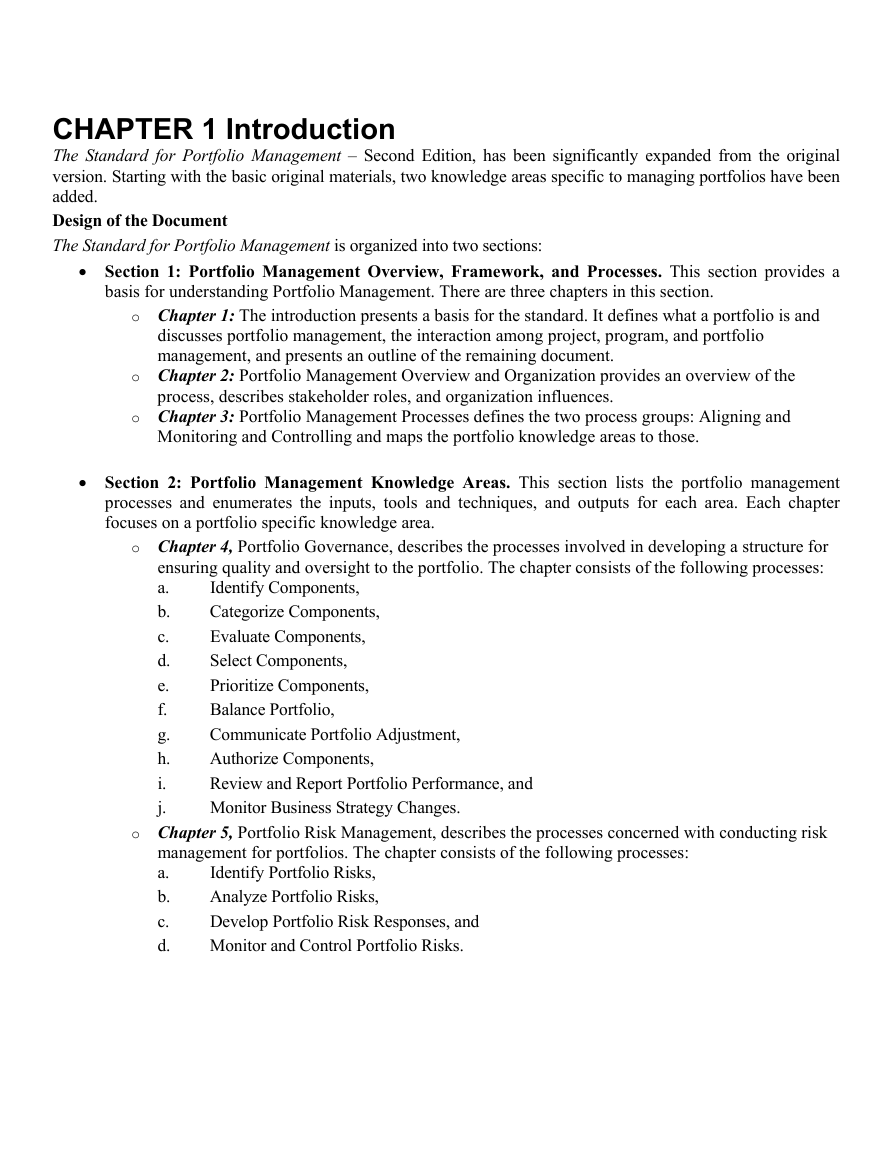
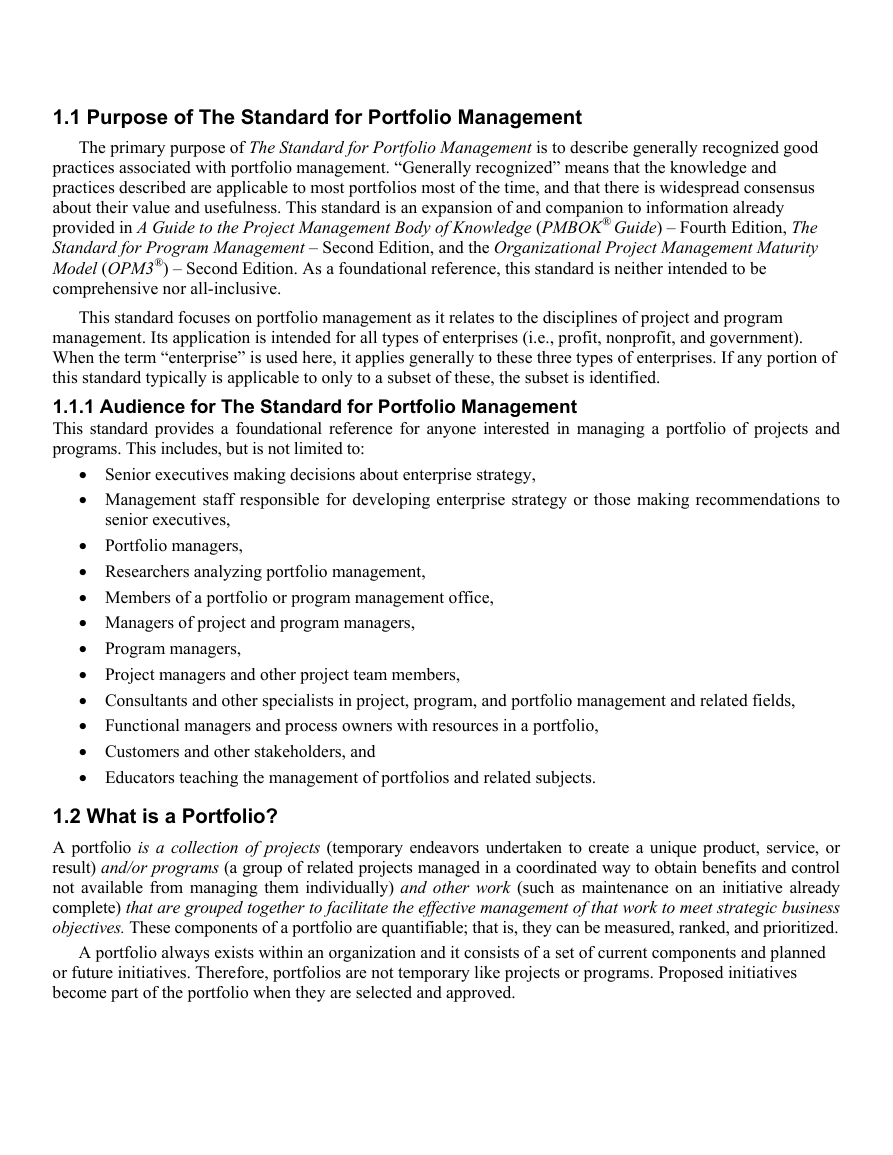

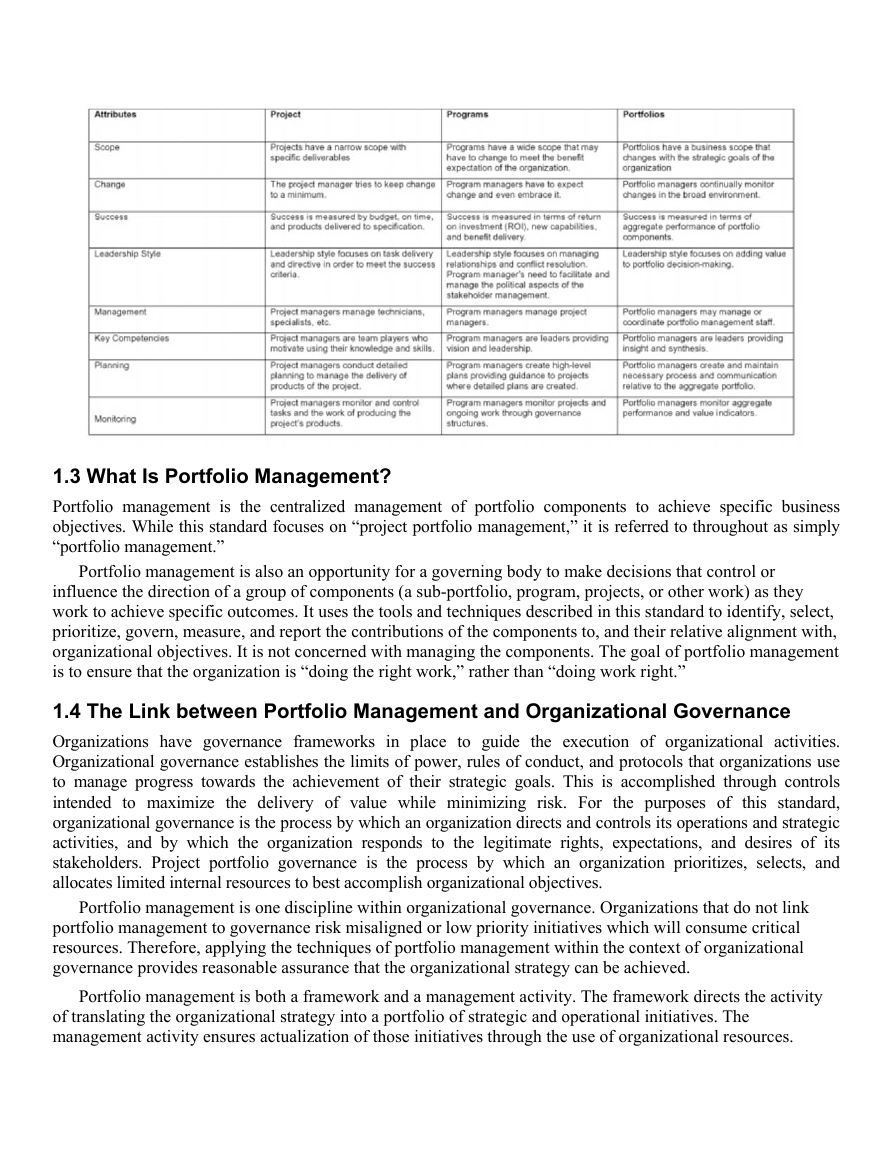
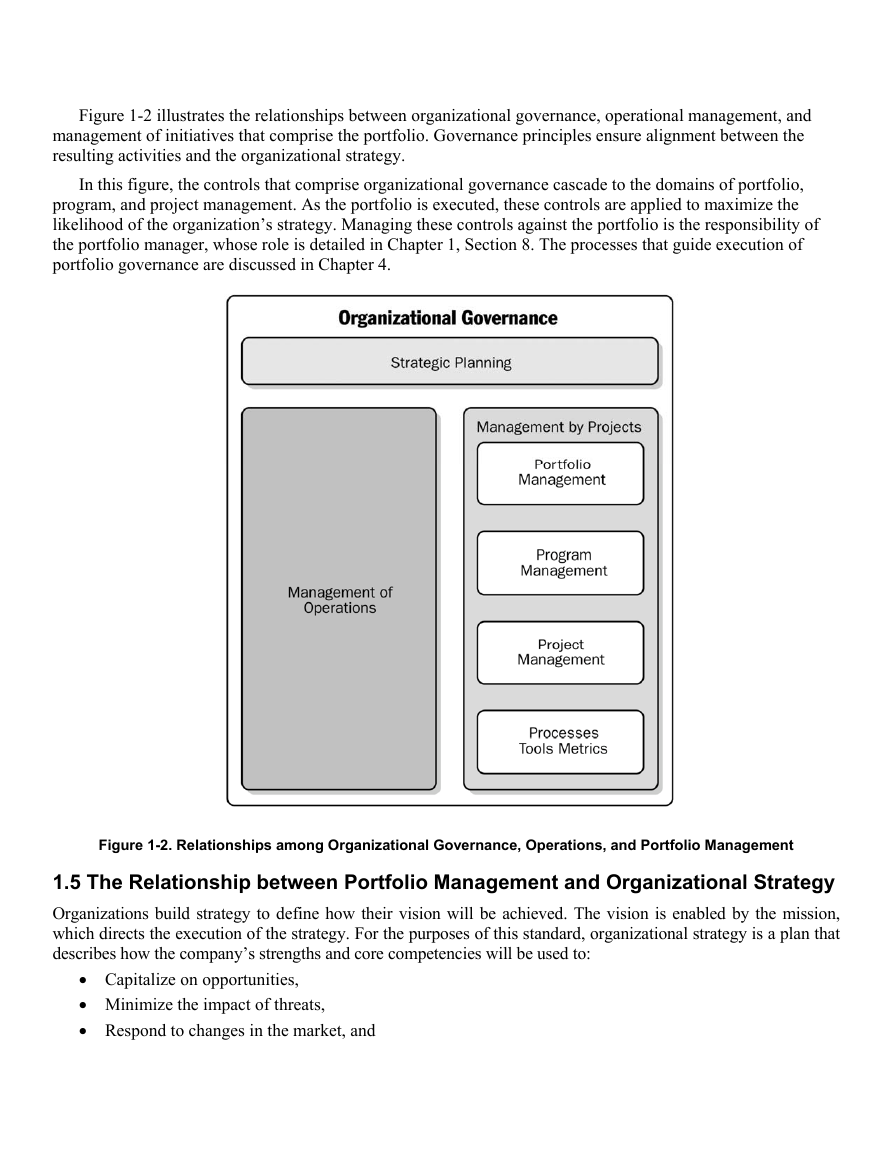
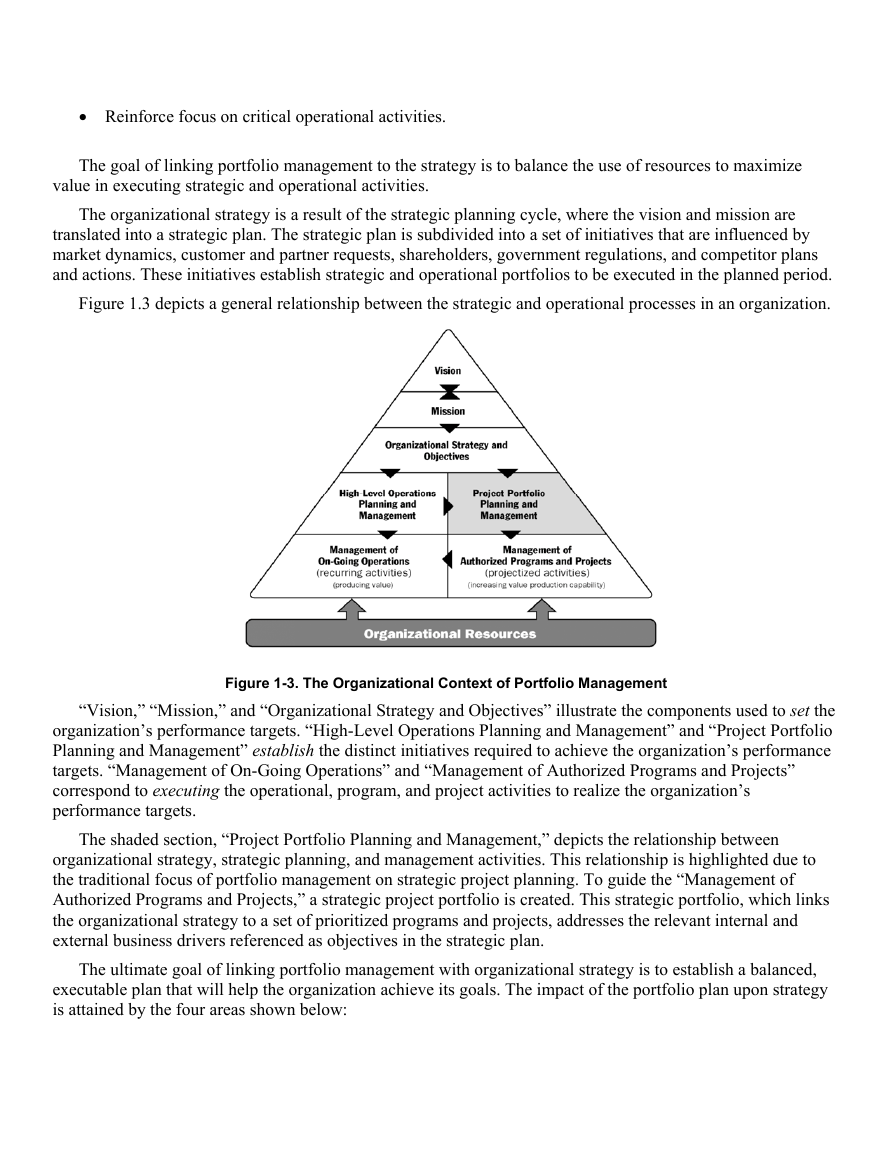
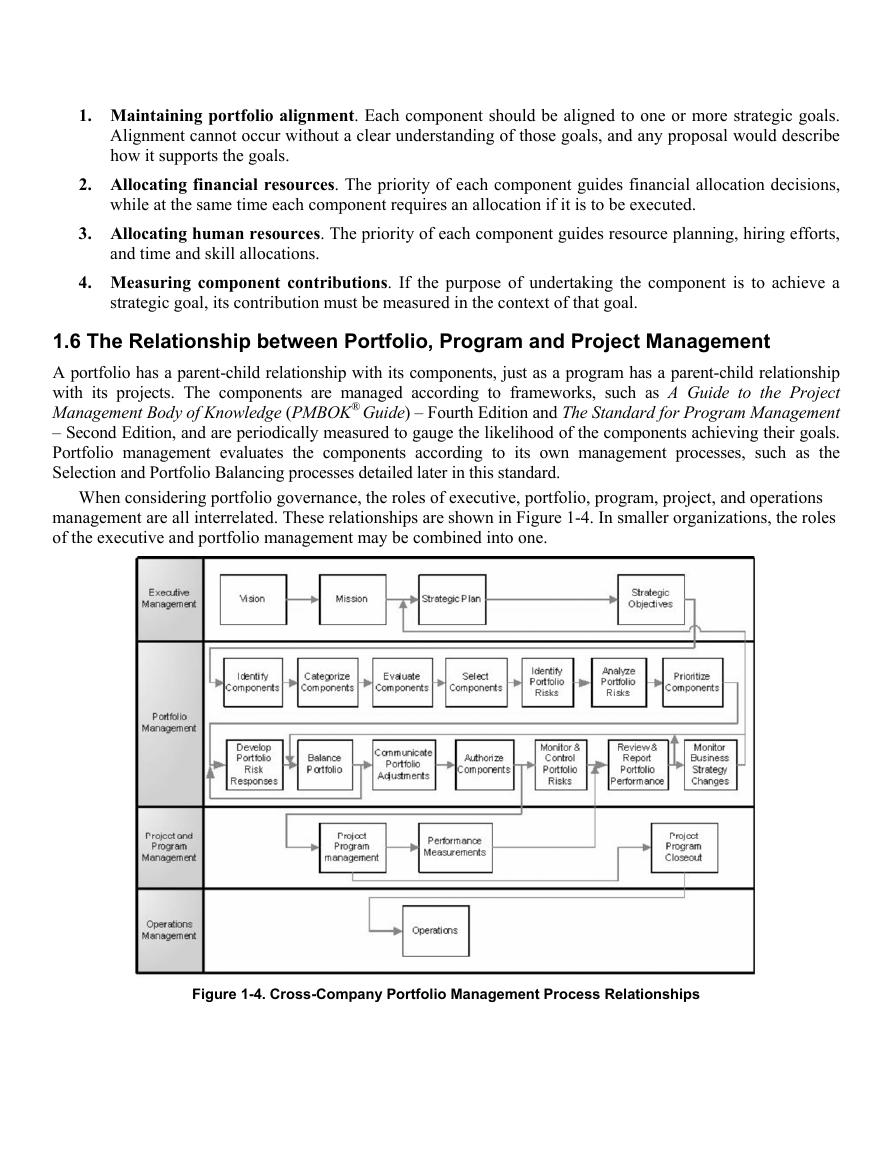









 2023年江西萍乡中考道德与法治真题及答案.doc
2023年江西萍乡中考道德与法治真题及答案.doc 2012年重庆南川中考生物真题及答案.doc
2012年重庆南川中考生物真题及答案.doc 2013年江西师范大学地理学综合及文艺理论基础考研真题.doc
2013年江西师范大学地理学综合及文艺理论基础考研真题.doc 2020年四川甘孜小升初语文真题及答案I卷.doc
2020年四川甘孜小升初语文真题及答案I卷.doc 2020年注册岩土工程师专业基础考试真题及答案.doc
2020年注册岩土工程师专业基础考试真题及答案.doc 2023-2024学年福建省厦门市九年级上学期数学月考试题及答案.doc
2023-2024学年福建省厦门市九年级上学期数学月考试题及答案.doc 2021-2022学年辽宁省沈阳市大东区九年级上学期语文期末试题及答案.doc
2021-2022学年辽宁省沈阳市大东区九年级上学期语文期末试题及答案.doc 2022-2023学年北京东城区初三第一学期物理期末试卷及答案.doc
2022-2023学年北京东城区初三第一学期物理期末试卷及答案.doc 2018上半年江西教师资格初中地理学科知识与教学能力真题及答案.doc
2018上半年江西教师资格初中地理学科知识与教学能力真题及答案.doc 2012年河北国家公务员申论考试真题及答案-省级.doc
2012年河北国家公务员申论考试真题及答案-省级.doc 2020-2021学年江苏省扬州市江都区邵樊片九年级上学期数学第一次质量检测试题及答案.doc
2020-2021学年江苏省扬州市江都区邵樊片九年级上学期数学第一次质量检测试题及答案.doc 2022下半年黑龙江教师资格证中学综合素质真题及答案.doc
2022下半年黑龙江教师资格证中学综合素质真题及答案.doc